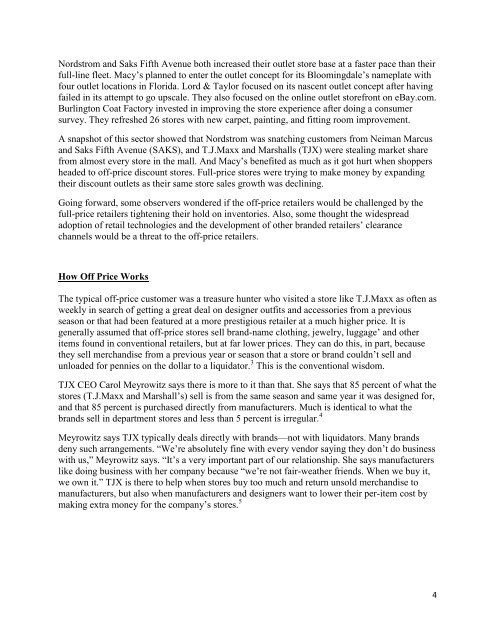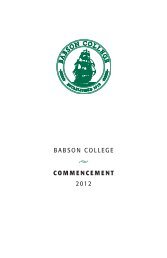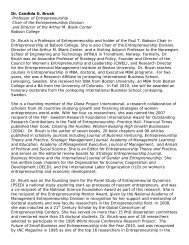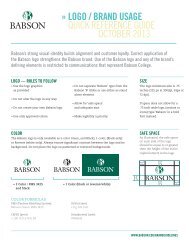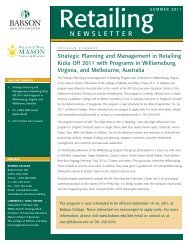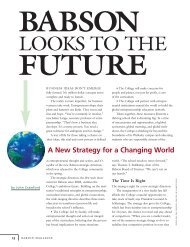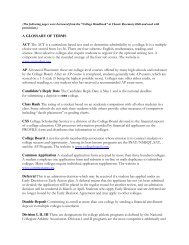TJ Maxx - Babson College
TJ Maxx - Babson College
TJ Maxx - Babson College
You also want an ePaper? Increase the reach of your titles
YUMPU automatically turns print PDFs into web optimized ePapers that Google loves.
Nordstrom and Saks Fifth Avenue both increased their outlet store base at a faster pace than their<br />
full-line fleet. Macy’s planned to enter the outlet concept for its Bloomingdale’s nameplate with<br />
four outlet locations in Florida. Lord & Taylor focused on its nascent outlet concept after having<br />
failed in its attempt to go upscale. They also focused on the online outlet storefront on eBay.com.<br />
Burlington Coat Factory invested in improving the store experience after doing a consumer<br />
survey. They refreshed 26 stores with new carpet, painting, and fitting room improvement.<br />
A snapshot of this sector showed that Nordstrom was snatching customers from Neiman Marcus<br />
and Saks Fifth Avenue (SAKS), and T.J.<strong>Maxx</strong> and Marshalls (<strong>TJ</strong>X) were stealing market share<br />
from almost every store in the mall. And Macy’s benefited as much as it got hurt when shoppers<br />
headed to off-price discount stores. Full-price stores were trying to make money by expanding<br />
their discount outlets as their same store sales growth was declining.<br />
Going forward, some observers wondered if the off-price retailers would be challenged by the<br />
full-price retailers tightening their hold on inventories. Also, some thought the widespread<br />
adoption of retail technologies and the development of other branded retailers’ clearance<br />
channels would be a threat to the off-price retailers.<br />
How Off Price Works<br />
The typical off-price customer was a treasure hunter who visited a store like T.J.<strong>Maxx</strong> as often as<br />
weekly in search of getting a great deal on designer outfits and accessories from a previous<br />
season or that had been featured at a more prestigious retailer at a much higher price. It is<br />
generally assumed that off-price stores sell brand-name clothing, jewelry, luggage’ and other<br />
items found in conventional retailers, but at far lower prices. They can do this, in part, because<br />
they sell merchandise from a previous year or season that a store or brand couldn’t sell and<br />
unloaded for pennies on the dollar to a liquidator. 3 This is the conventional wisdom.<br />
<strong>TJ</strong>X CEO Carol Meyrowitz says there is more to it than that. She says that 85 percent of what the<br />
stores (T.J.<strong>Maxx</strong> and Marshall’s) sell is from the same season and same year it was designed for,<br />
and that 85 percent is purchased directly from manufacturers. Much is identical to what the<br />
brands sell in department stores and less than 5 percent is irregular. 4<br />
Meyrowitz says <strong>TJ</strong>X typically deals directly with brands—not with liquidators. Many brands<br />
deny such arrangements. ―We’re absolutely fine with every vendor saying they don’t do business<br />
with us,‖ Meyrowitz says. ―It’s a very important part of our relationship. She says manufacturers<br />
like doing business with her company because ―we’re not fair-weather friends. When we buy it,<br />
we own it.‖ <strong>TJ</strong>X is there to help when stores buy too much and return unsold merchandise to<br />
manufacturers, but also when manufacturers and designers want to lower their per-item cost by<br />
making extra money for the company’s stores. 5<br />
4


